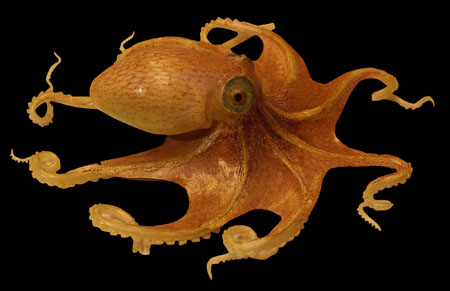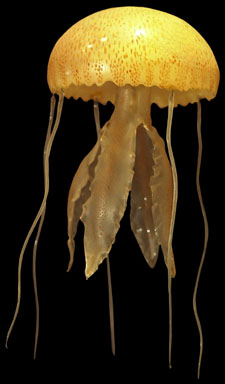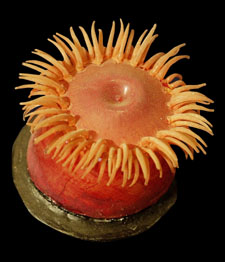These creatures see dusty duty
Staff photos by Jon Chase

The man-of-war’s blue sail shone under the display case’s bright lights, the glass tentacles of the jellyfishlike animal so delicate that the tread of a visitor to the Museum of Comparative Zoology’s Invertebrate Department sets them waving. Where its live counterparts – poisonous colonies of creatures called siphonophores – drift in a salty sea, the glass model is sailing in a sea of time, bringing ancient craftsmanship to the present.
The man-of-war is just one of about 360 glass animals housed at the Harvard Museum of Comparative Zoology. They were created in the late 1800s by the father and son team of Leopold and Rudolph Blaschka, creators of the Harvard Botanical Museum’s famous Glass Flowers.
The glass creatures illustrate exotic and alien animals that dot the sea floor and drift on ocean currents, from the more familiar squid and octopuses, to otherworldly nudibranchs, ghostly ctenophores, marine worms, and microscopic protozoa.

Though rarely used for teaching today, the models were originally a valuable asset in showing how certain creatures look. The collection, created between 1865 and 1886, is made up mainly of soft-bodied animals, such as the nearly transparent comb jellies, which fall apart when they’re collected, or marine worms that change color and shrivel up when preserved.
“These are very hard to keep as samples,” said Gonzalo Giribet, assistant professor of biology and assistant curator of invertebrates. “You either see them alive or look at a model.”
The collection also features creatures that were just plain tough to obtain, such as the sluglike Glaucilla marginata, which concentrates the poison of its jellyfish prey in gill-like projections along its inch-long purplish body.
“These animals, living in the open ocean, are difficult to collect and quite poisonous,” said professor of biology Kenneth Boss, curator of malacology in the Museum of Comparative Zoology.
The glass animals also illustrate very tiny creatures, such as microscopic protozoa, that would be difficult to study directly. Magnified many times, the three-dimensional models show these otherworldly creatures as glass models that can be held up and viewed from every angle.

Reproducing color and form, including delicate glass tentacles, spines and feathery gills, the creatures show the same artistry that marks the Blaschkas’ work reproducing plants. Though they have common beginnings, however, the sea creatures and Glass Flowers have traveled very different roads.
Where the Glass Flowers are one-of-a-kind models of plants created specifically for Harvard, the glass mollusks, worms, and other sea creatures were manufactured en masse and sold through Ward’s Natural Science Establishment catalog for as little as 50 cents apiece.
While the rarity and beauty of Harvard’s Glass Flowers have won them fame and made them the Harvard Museum of Natural History’s (HMNH) most popular exhibit, the glass animals exist in relative obscurity.
The glass animals are scattered in isolated display cases and in specimen drawers in different departments. Several are on display at the HMNH, as part of its exhibit “Dodos, Trilobites & Meteorites … Treasures of Nature and Science at Harvard” and as examples of the Blaschkas’ early work in telling the story of the Glass Flowers.
“They [the glass animals] were great models, they were very elaborate,” said Susan Rossi-Wilcox, curatorial associate in the Harvard University Herbaria and administrator of the Glass Flowers. “It’s my impression that at the time, they were extremely well done. They were probably the best thing out there.”
Rossi-Wilcox said though the glass animals highlight much of the same techniques and artistry as the Glass Flowers, they haven’t been considered very special since they were initially acquired.
“They weren’t exactly a dime a dozen. They were very expensive models [then],” Rossi-Wilcox said. “[But] the Blaschkas were making these things literally by the hundreds, even thousands. It’d be like going to a biological supply house now. You buy something plastic. If you break it, you buy another.”
Consequently, Rossi-Wilcox said, there’s never been an inventory conducted of Blaschka glass animal holdings in the United States. Harvard is thought to have one of the largest collections, but others exist at Cornell University, the Museum of Science in Boston, and the Academy of Natural Sciences of Philadelphia, according to a study of the Harvard collection published in 1978.
Less glass, more photos
Of course, today’s students can study photographs to see what a creature looks like. They can view a video to see its behavior. Or study its growth with three-dimensional computer modeling. All that, combined with some questions as to the scientific accuracy of some of the glass animals, have all but eliminated any scientific value the models have.
“Now we have them more for their beauty, as an internal exhibit, than for any scientific purpose,” Giribet said.




